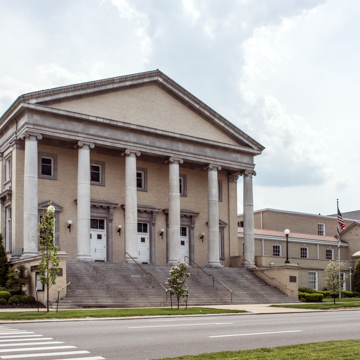This large, temple-fronted, yellow brick church is a good example of one of the most familiar Protestant types of the twentieth century. Its pedimented, hexastyle Ionic portico, composed of limestone columns and entablature, is approached by a broad flight of steps. The interior has been remodeled several times, but the basic original arrangement, with choir, baptistery, and organ as major focal points, remains, as does an impressive paneled ceiling. The original Sunday school wing at the rear has been supplemented by a major addition on the side.
Plans and a perspective rendering of the church were shown in Church and Sunday School Buildings (1917), published by the Sunday School Board of the Southern Baptist
R. H. Hunt (1862–1937), of Chattanooga, was a prolific designer of churches throughout the South. Harold E. Wagoner, of Philadelphia, another prolific church architect, designed the large side addition, including a chapel. John W. Winterich and Associates remodeled the sanctuary in 1968.






